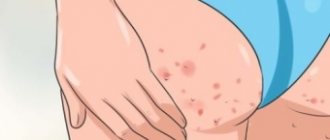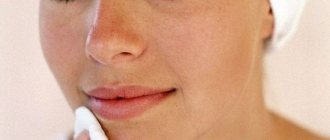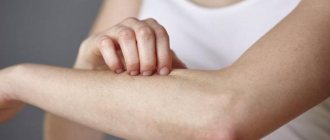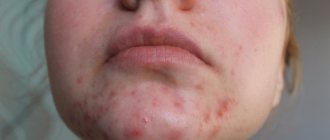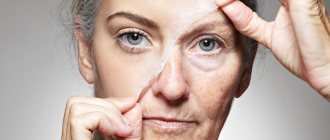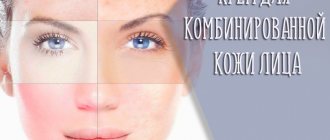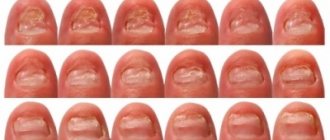The condition of facial skin is a reflection of the functioning of internal organs and systems. In case of any violations, areas of irritation and peeling appear on the epidermis. The greatest discomfort for women and men is caused by subcutaneous acne on the forehead. Most often, they are large in size, difficult to disguise with decorative cosmetics, and difficult to respond to complex therapy using medications and folk remedies.
Common Causes
Subcutaneous pimples on the forehead are foci of inflammation formed as a result of the accumulation of large amounts of sebum in the pores and their blockage. A cosmetic defect often occurs in young and middle-aged patients. Experts noted that people with an oily type of epidermis are more susceptible to rashes. There are several reasons that can provoke the problem:
- diseases of the endocrine system: diabetes mellitus, hypo- and hyperthyroidism, obesity;
- diseases of the digestive system: gastritis, gastroduodenitis, damage to the liver and gall bladder, pancreas, small intestine;
- tendency to constipation, which provokes the accumulation of large amounts of toxins and harmful substances in the body;
- hormonal disorders;
- frequent stressful situations due to professional activities;
- nervous tension, disturbance of psycho-emotional state;
- diseases of the urinary system in the acute stage;
- infectious pathologies at the initial stage;
- chronic vitamin deficiency;
- unbalanced diet;
- bad habits;
- predisposition to skin problems;
- chronic dermatological diseases;
- regular overwork, physical exhaustion;
- abuse of decorative cosmetics or aggressive peelings and scrubs.
Any of the factors can provoke increased activity of the sebaceous glands and the production of large amounts of sebum. In the warm season, cosmetic defects appear much more often, which is associated with additional contamination of the epidermis with dust, as well as exposure to sunlight.
Women during pregnancy are more susceptible to the formation of subcutaneous acne on the forehead. It is rarely possible to get rid of them in a short time, since the root cause is a change in hormonal levels. , people regularly in contact with harmful substances, and women during menopause are also at risk
Features of education
Hard pimples on the forehead are formed as a result of clogging of the pores with sebum due to intensive work of the sebaceous glands. Sebum is a natural protective barrier for the epidermis and prevents the negative effects of environmental factors.
However, when a large amount of sebum is produced, it mixes with dust and closes the skin pores. The glands do not stop working, so after a while the sebaceous ducts become clogged, and a focus of inflammation appears on the skin. In a humid and oily environment, pathogenic microorganisms develop very quickly, causing the pimple to enlarge and aggravate the pathological process.
If a person ignores the problem and does not take any measures to eliminate the source of inflammation, the process of suppuration begins. The pimple increases in size, painful sensations appear when touched and when performing hygiene procedures. Sometimes small lesions appear nearby and enlarge over time. In advanced cases, a huge pimple on the forehead provokes the spread of the rash throughout the face. Patients may complain of pain and itching in the affected area, which indicates the progression of the process and the need for immediate treatment.
Photo
see photo
There are subcutaneous pimples, and there are ordinary small acne. The difference is immediately visible, subcutaneous ones are deeper, and therefore take longer to treat and are much more difficult. The small ones look like a rash. The forehead becomes strewn with small inflammations, but they are easier to treat. It is important to start solving this problem in time.
The topic of treating subcutaneous lesions on the forehead was discussed in the above article.
Diagnostic methods
You can get rid of the problem yourself only if a small outbreak appears. In case of multiple and painful rashes, it is recommended to consult a dermatologist who will conduct a comprehensive examination, identify the root cause and prescribe appropriate therapy.
At the first appointment, the doctor examines the affected area, interviews the patient, identifies eating and professional habits, lifestyle, and the presence of chronic pathologies of internal organs. After this, a general blood test, determination of glucose levels, and a biochemical blood test are prescribed.
Women are often given blood tests for thyroid and sex hormones. This will allow you to identify deviations and eliminate them. Sometimes an ultrasound examination of the abdominal organs is required. If large pimples on the forehead with signs of suppuration spontaneously open up, the specialist takes a scraping from the lesion to identify bacterial microflora. Often this analysis allows you to select effective drugs to combat the problem. After receiving the examination results, appropriate treatment is prescribed.
Types of acne
In medicine, there are several types of acne that can affect the forehead area. They are divided into two large groups.
Open
These include blackheads, acne and ulcers. The causes of their occurrence are most often contamination of the skin and the influence of external factors. They appear mainly in women who use powder, foundation and in people who lead an unhealthy lifestyle.
Smoking, drinking alcohol and eating fast foods significantly increases the risk of open acne.
Closed
This group includes ulcers, cysts and small red pimples. The provocateurs of their formation are disturbances in the functioning of internal organs. In appearance they resemble small bumps or nodules.
Different types of acne require different treatment approaches. Before prescribing the necessary drugs or procedures, the doctor must determine the cause of their occurrence.
Pharmacy drugs
You can remove internal acne on the forehead with the help of various medications that affect the development of the inflammatory process. Most often they are used externally and allow you to get noticeable results after 2-3 weeks of regular use. The following are considered the most effective:
- Hormonal preparations for external use: Gioksizon, Celestoderm. Help eliminate rashes caused by hormonal changes in the body. Most often prescribed to adolescents and women with menstrual irregularities and the appearance of acne, during menopause. Men use such products less often, since hormonal disorders affect them infrequently. Medicines are used in courses of 10-14 days.
- Antibacterial products: Zerkalin, Zinerit. Used in case of bacterial etiology of rashes. They are especially often prescribed to teenagers who squeeze out pimples with dirty hands, causing inflammation and worsening the problem. The drugs help suppress the causative agents of the rash and stop the proliferation of pathogenic microorganisms. Typically, medications are used for 4-8 weeks, depending on the degree of neglect of the condition.
- Anti-inflammatory medications: Voltasept, Baziron AS. The drugs quickly relieve inflammation when multiple lesions form. After several days of use, redness and swelling of the tissues disappear, pain decreases, and rashes become less noticeable. The full course lasts up to 4 weeks. Usually this time is enough to completely eliminate the symptoms of inflammation.
- Medicines to reduce sebum production: Azelik, Skinoren. They help normalize the functioning of the sebaceous glands, cleanse the pores of the skin, improve the processes of renewal and restoration of epidermal cells. When used for 2 weeks, the skin condition improves significantly, rashes gradually disappear. By reducing the secretion of sebum, new lesions do not form.
Sometimes dermatologists prescribe keratolytics, for example, Zinc or Salicylic ointment. The drugs have an anti-inflammatory and drying effect, therefore they improve the condition of the epidermis and reduce the number of acne. The products are applied precisely to the area of inflammation.
Treatment
The main condition for successful treatment is a comprehensive effect on the cause of inflammation. The action of the drugs is based on eliminating microbes, reducing inflammation, reducing the activity of the sebaceous glands, and astringent properties.
Most popular: Seven ways to look younger after 40
Medicines
Zenerite. It is characterized by antimicrobial, anti-inflammatory and comedolytic effects. Fights acne that is resistant to cosmetic and hygiene products. Contains erythromycin and zinc. Universal packaging allows you to conveniently store and use the solution.
Baziron AS. It comes in the form of a gel and can have different concentrations. The highest is chosen for severe cases of skin damage. The drug fights inflammation, saturates cells with oxygen, reduces the formation of sebum, and adsorbs existing deposits.
Skinoren. Creamy or gel consistency is convenient for application to individual areas of the skin. The main component, azelaic acid, actively fights bacteria. Since the product is also intended to combat hyperpigmentation, it protects the skin from UV.
Erythromycin ointment. The active substance blocks the synthesis of proteins at the cellular level of microorganisms and stops their spread. It is one of the oldest antibiotics and is used even in the presence of allergies. May be prescribed in the form of ointment or tablets.
Differin. The main substance is adapalene. Targeted at eliminating acne. Apply to affected areas before bedtime. It can be used as a monotherapeutic agent or in combination with local or systemic drugs. Well tolerated by dry and sensitive skin.
Salon treatments
Often the use of drugs does not help eliminate the problem completely. Most people note that small rashes remain, and traces of large pimples that have disappeared also become noticeable. Today, professional beauty salons offer many procedures to get rid of acne, as well as marks after their removal:
- Mesotherapy is one of the popular methods of combating various dermatological problems. The essence of the procedure is to inject special solutions under the skin that accelerate metabolic processes, help relieve inflammation, and prevent the rash from spreading to healthy areas. To achieve a visible result, you will need from 1 to 3 procedures, depending on the initial state of the epidermis. Mesotherapy is usually recommended for women over 45 years of age, as it helps smooth out fine wrinkles and improve the health of the skin.
- Chemical peeling is indicated for patients with normal to oily skin. Manipulation involves treating problem areas with special chemicals that remove dead cells. After the session, the processes of regeneration and renewal of the skin begin. Small pimples and areas of irritation disappear. The procedure is contraindicated for patients with a sensitive type of epidermis. After the procedure, it is recommended to protect the skin from the negative effects of environmental factors for about 5-7 days.
- Ultrasonic cleaning is a popular and painless method of getting rid of rashes. During the session, a specialist applies ultrasound to the skin using a special attachment. Under the influence of rays, the epidermis is renewed, regeneration processes are stimulated, and the symptoms of inflammation are eliminated. After 2-4 procedures, the skin takes on a healthy appearance. Cosmetologists claim that regular procedure leads to normalization of the sebaceous glands and prevents the formation of internal acne.
It is worth noting that some procedures are contraindicated in the case of the formation of a large pimple with signs of suppuration and damage to surrounding tissues. Exposure to chemicals or ultrasound can cause pathogens to enter the bloodstream. Before visiting the salon, it is recommended to consult with a specialist and make sure there are no contraindications.
What do beauty salons offer?
Mechanical cleaning is performed by a cosmetologist using special devices and antibacterial agents. This procedure is possible only at a certain degree of maturation of the pimple.
The result of ozone therapy is the relief of pain and redness. Reduces the risk of residual effects in the form of scars. Promotes the production of collagen and elastin necessary for cell regeneration.
Elos technology is based on pulsed blue light. It soothes the skin, tightens pores, accelerates healing and restoration of damaged tissue. Also a procedure without side effects melsmon.
Folk remedies
At home, you can use natural ingredients that help relieve inflammation and regulate sebum production. The following are considered the most effective:
- White clay is a simple and effective facial skin care product. You can buy the powder at the pharmacy and prepare a mixture for the mask from it. Separate a tablespoon of clay and add a little water to get a thick mass. After this, apply the mixture with a brush to your forehead and leave for 20 minutes. Repeat three times a week to get lasting results. If necessary, the composition can be distributed over the entire face if the epidermis is highly oily.
- A mixture of oatmeal and honey is often used for inflammatory skin pathologies. It is necessary to grind 30 g of flakes using a coffee grinder, add a little honey until a paste forms, apply the composition to problem areas or the entire face, leave for 20 minutes. After removing the mixture, you can use a moisturizer to improve the condition of the skin. Use the recipe for a month, once every three days.
- Aloe juice helps to cope not only with small rashes, but also with large pimples, and has anti-inflammatory and regenerating properties. To eliminate a cosmetic defect, it is necessary to treat the lesions with freshly squeezed juice every morning and evening. The product should be stored in the refrigerator. Use until large pimples and signs of irritation disappear.
- Fresh parsley is considered a good remedy for fighting acne, as it contains valuable substances that have anti-inflammatory and antiseptic effects. For treatment, you will need to grind fresh herbs into a paste, apply to the affected areas and leave for 30 minutes. Repeat twice a week for a month. Like other healing compounds, parsley can be applied all over the face to improve color and eliminate fine lines.
An additional element of therapy will be diet correction, exclusion from the menu of fatty, fried, salty, spicy, sour, baked goods, confectionery, alcoholic and carbonated drinks, and strong coffee. This will allow you to work on the skin from the inside. It is also recommended to drink at least 2 liters of water per day, which will improve metabolism.
